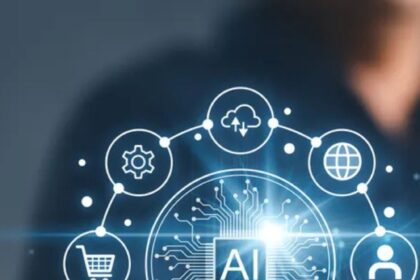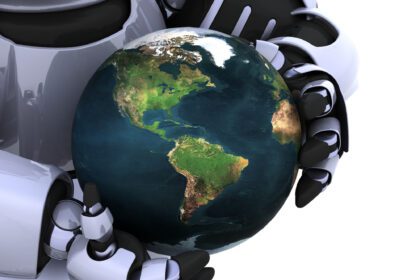Artificial intelligence (AI) is no longer a distant promise it has become a pervasive force reshaping how, where and why we work. From automating routine tasks to enabling new forms of collaboration, this transformation is both profound and rapid. In this article, we examine how AI is redefining roles, organizations and skills across the global workforce. We’ll explore practical examples, data-driven insights and actionable strategies for leaders and professionals navigating this shift.
The Changing Nature of Tasks and Roles
One of the clearest shifts driven by AI is what work gets done and by whom. Tasks that were once human-only are increasingly handled (or aided) by AI systems, and human roles are evolving in parallel.
According to a recent report from McKinsey & Company, employees are using AI more than many leaders realise three times more likely to think AI will replace 30 % of their work in the next year. Meanwhile, the International Business Machines Corporation (IBM) notes that new job categories are emerging and uniquely human capabilities like creativity, emotional intelligence and adaptability are becoming more valuable.
For example:
- A software-engineer might focus less on hand-coding every function and more on defining the “why” of the system while AI handles scaffolding or testing.
- A sales professional might spend less time generating slide decks and more time nurturing strategic client relationships, with AI supporting the behind-the-scenes work.
- Even administrative tasks once thought stable are increasingly exposed. In a 2025 report from the Indeed Hiring Lab, 26 % of job postings were judged to be “highly” transformable by generative AI; 46 % of skills in a typical U.S. job posting fall under hybrid transformation.
These shifts suggest the very architecture of work is changing jobs are being reframed, tasks redistributed and roles hybridised. Organisations that understand this earliest gain a competitive edge.

Accelerating Productivity and Business Models
AI is not just redefining tasks it is enabling new business models, changing productivity dynamics and creating competitive advantage.
From the PricewaterhouseCoopers (PwC) “Jobs Barometer” we learn that in industries most exposed to AI, revenue per employee has grown nearly fourfold since 2022, and wages are rising twice as fast in AI-exposed sectors.
Likewise, Microsoft’s “Frontier Firm” research shows that early AI adopters organisations deploying AI at scale report 55 % are able to take on more work than counterparts (versus 25 % globally) and 90 % say employees are doing more meaningful work.
These findings underscore that AI is more than a cost-cutting tool it can unlock growth, innovation and higher-value work. But the caveat is clear: benefits only accrue when the organisation rethinks workflows, not simply plugs in the tech. As McKinsey warns, “the biggest barrier to success is leadership.”
Skills, Workforce Strategy and Organisational Impacts
With tasks changing and productivity shifting, the focus turns to people. What skills matter? How should organisations reconfigure teams and hiring?
Skill shifts
As the PwC report highlights: skills in AI-exposed jobs are changing 66 % faster than in others; workers with AI-relevant skills command a 56 % wage premium.
According to McKinsey, employees are three times more likely than leaders to believe AI will replace 30 % of what they do in the next year.
In short: AI fluency, systems thinking, problem-framing, human judgement and cross-functional collaboration are emerging as core capabilities. There is less value in purely repetitive work and more in integrating humans and machines.
Organisational design
In their recent report, McKinsey and BCG note that team structures are shifting: traditional pyramids are giving way to flatter, flexible pods where human-AI collaboration is built in from the ground up.
Roles are broadening and blending: engineers become co-creators with AI agents; product managers oversee AI-driven workflows; QA professionals shift toward oversight of autonomous systems.
Strategy and leadership
The adoption of AI is not a tactical initiative. According to McKinsey: “The risk for business leaders is not thinking too big, but rather too small.”
Organisations must align technology, talent and culture ensuring governance, ethics, upskilling, and adaptation are built into the change process. The winners will be those who treat AI as a strategic shift in how work is done, rather than an “add-on” tool.
Global and Sector Perspectives
While many of the insights above originate in U.S. and Western contexts, the impact of AI is truly global, with both regional differences and cross-border opportunities.
For instance:
- In emerging markets, adoption of AI tools is accelerating and workers report higher trust in AI in some cases. A global study by KPMG covering 47 countries found trust and usage patterns vary significantly by region.
- The fact that AI skills command premiums means that talent markets globally will polarise: those who adapt will gain; those who don’t may be left behind.
- Certain sectors are more exposed than others: For example, knowledge-work domains with heavy reliance on routine tasks (financial services, content creation, service desk) are seeing faster transformation. The Indeed Hiring Lab report shows occupations like nursing have lower exposure to full AI transformation compared to software roles.
Thus, leaders in Asia, the Middle East, Africa, Latin America need to calibrate: adopt AI tools, invest in skills, but also tailor to local regulatory, cultural and workforce realities.
Case Study: Reframing Work in Practice
Let’s look at a concrete example to illustrate these shifts.
Case: A global finance firm
A large finance firm adopted an AI-powered platform to handle routine investment-analyst tasks: data gathering, preliminary modelling, report drafting. Humans shifted into roles of oversight, strategy and client interaction.
Outcomes:
- Analysts who embraced the platform were able to double the number of client-facing interactions per week (productivity gain)
- The firm retrained mid-career analysts into “AI-augmented advisors” – those who validate the AI outputs, then craft the high-value narrative and strategy
- Recruitment changed: less weight on brute modelling skills, more on conceptual thinking, client empathy, AI-tool literacy
This mirrors what McKinsey calls a shift from execution to design, oversight and value creation.
Lessons
- The technology itself is not enough. A meaningful redesign of roles and workflows is required.
- Upskilling is essential, and needs to go beyond simply “use the tool” to “co-work with the tool”.
- Organisations that treat this change as fluid and systemic outperform those that treat it as a one‐off automation project.
Risks, Ethical Considerations and What to Watch
While the opportunities are vast, the transformation carries risks and challenges.
Risks & ethical issues
- Skill and employment displacement: Although many roles will evolve rather than vanish, some tasks and jobs will be disrupted. For example, the Indeed report estimates 26 % of jobs posted could be “highly” transformed by generative AI.
- Governance and trust: The KPMG study shows over half of workers admitted to hiding their use of AI at work—raising concerns about transparency, compliance and governance.
- Workload and fragmentation: The Microsoft Work Trend index indicates that while AI boosts productivity, business pace is still out-pacing humans leading to fragmentation and overload.
What to watch
- Measurement of value: Many organisations claim AI saves time, but turning time-saved into meaningful value remains a challenge. For instance, the Adecco Group 2025 report shows workers believe they save up to two hours daily, but much of that gains in productivity are being re-absorbed into other work.
- Skill gaps and reskilling cadence: With skills shifting faster than ever (66 % faster in some cases) organisations must invest in continuous learning.
- Work design and boundaries: As roles broaden and blend, job definitions become fluid. This can lead to identity ambiguity, stress or misalignment unless well managed (see academic research on job-crafting in AI era).
Key Actions for Leaders and Professionals
To thrive in an era where AI is redefining work, both organisations and individuals must act proactively.
For organisations:
- Map your tasks & roles – Identify which workflows are AI-ready and redesign roles accordingly.
- Invest in skills and culture – Prioritise AI fluency, systems thinking, prompt literacy, and human-AI collaboration.
- Shift organisational structures – Move from rigid hierarchies to agile, hybrid human-AI teams.
- Govern responsibly – Develop frameworks for ethical AI use, transparency and trust.
- Measure meaningful outcomes – Move beyond “time saved” to “value created”, “employee engagement” and “customer impact”.
For professionals:
- Embrace lifelong learning – Be ready to upskill, reskill and adapt; your job may change more than you expect.
- Develop uniquely human strengths – Creativity, emotional intelligence, judgment and collaboration will be differentiators.
- Build AI literacy – Understand how tools work, how they can be directed, validated and improved.
- Be proactive in role-shaping – Don’t wait for the job to change you think about how you will change your job.
- Cultivate agility and curiosity – In an era of rapid change, being adaptable, curious and growth-oriented is as vital as technical skill.
Conclusion
Artificial intelligence is not just another technological wave it is redefining the very fabric of work. From tasks and roles to teams and skills, the changes are broad, deep and accelerating. Organisations that treat AI as a strategic enabler of human potential and professionals who position themselves as AI-savvy collaborators will shape the future of work. The time to act is now: redesign roles, reskill people and embed AI not just into tools but into work itself.
Forward outlook
In the next 3-5 years, we will see:
- More “hybrid” roles where humans and AI agents co-create value
- Flatter, more agile organisational structures that embed AI as a team member rather than a tool
- Increased differentiation in the labour market: those with AI-fluency and human-centered skills will command premium opportunities
- A shift from “automation” conversations to “orchestration” and human-machine collaboration
By embracing this transformation intentionally, rather than reacting to it, businesses and professionals can not only survive but lead in the era of AI-enabled work.






